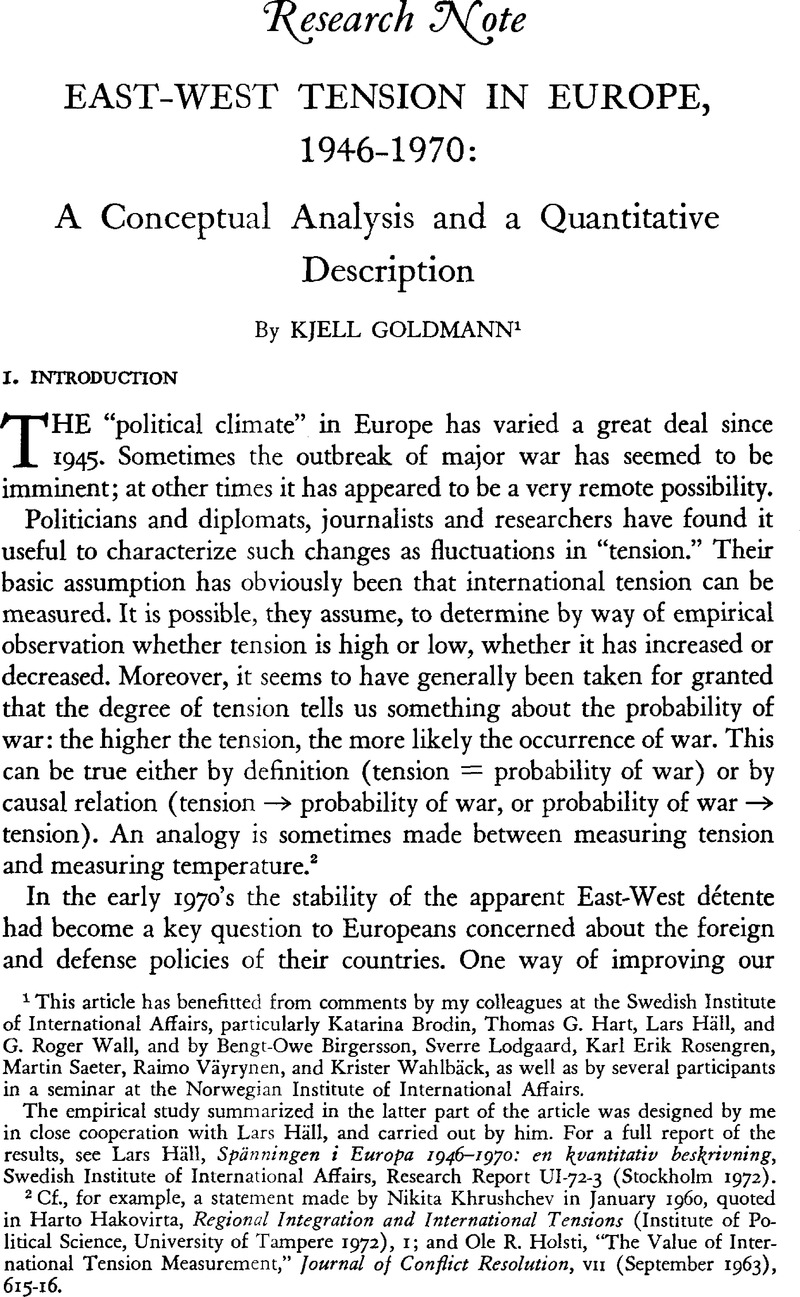Published online by Cambridge University Press: 18 July 2011

2 Cf., for example, a statement made by Nikita Khrushchev in January 1960, quoted in Harto Hakovirta, Regional Integration and International Tensions (Institute of Political Science, University of Tampere 1972), I; and Holsti, Ole R., “The Value of International Tension Measurement,” Journal of Conflict Resolution, VII (September 1963), 615–16Google Scholar.
3 Earlier attempts at tension measurement include Bergeron, Gerard, La guerre jroide inachevee (Montreal 1971)Google Scholar, particularly the diagram on p. 208; Newcombe, Alan G., “Towards the Development of an Inter-Nation Tensiometer,” Peace Research Society (International), Papers, in (1970), 11–27Google Scholar; Väyrynen, Raimo, Dimensions of International Tension, 1948-1968, Paper presented for the Fourth IPRA Conference (Bled, Yugoslavia 1971)Google Scholar. Two researchers gave up the idea of using the concept “tension” because they found no way of operationalizing it meaningfully: see Brody, Richard A. and Benham, Alexandra H., “Nuclear Weapons and Alliance Cohesion,” in Pruitt, Dean G. and Snyder, Richard C., eds., Theory and Research on the Causes of War (Englewood Cliffs, NJ. 1969), 168Google Scholar.
4 The theoretical background of our attempts to measure European tension are summarized in Goldmann, Kjell, “Bipolarization and Tension in International Systems: A Theoretical Discussion,” Cooperation and Conflict, VII, No. 1 (1972), 37–63CrossRefGoogle Scholar.
5 Cf. Gould, Julius and Kolb, William L., eds., A Dictionary of the Social Sciences (London 1964), 718Google Scholar; Pruitt and Snyder (fn. 3), 50.
6 Singer, J. David, “Threat-Perception and the Armament-Tension Dilemma,” Journal of Conflict Resolution, II (1958), 90–105CrossRefGoogle Scholar.
7 My present definition of tension differs from an earlier published version in this respect; cf. Goldmann (fn. 4), 51.
8 For a somewhat more extensive discussion see ibid., 48-50.
9 Ibid., 47-48.
10 Holsti (fn. 2), 613-17.
11 Janis, Irving L. and Fadner, Raymond, “The Coefficient of Imbalance,” in Harold D. Lasswell, Nathan Leites, and others, Language of Politics (New York 1949)Google Scholar.
12 Anckar, Dag, Partiopinioner och utrikespolitik (Åbo 1971), 34Google Scholar.
13 All nations that were members of one of the alliances at any time between 1946 and 1970 have been analyzed as if they had been members during the whole period.
14 Note that United States and Canadian statements are included in the total material only if they contain something about relations between European NATO members and some East European country or countries, or about relations between the two alliances as such. Statements that solely concern relations between the United States or Canada on the one hand and some East European country or countries on the other are not coded. The reason for the latter rule was our desire to measure European rather than global tension.
15 For details, see Hall (fn. 1), 37-42 and 97-103.
16 For details see ibid., 41 and 90-96. The high proportion of British statements of course reflects the fact that Keesing's Contemporary Archives is produced in Britain. Since we are only interested in measuring variations in tension, and since the “national” time series of the leading countries were highly intercorrelated (Hall [fn. 1], 61) the British “over-representation” is no serious problem.
17 The figures upon which the diagrams are based are available in ibid., 82-88.
18 The number of units is smaller than 50 for the following quarterly coefficients. Method I: 1962:2, 1962:3, 1965:3, 1969:3, and 1970:3. Method II: 1951:1, 1951:2, 1951:3, 1952:1, 1952:2, 1952:4, 1954:2, 1962:1, 1962:2, 1962:3, 1962:4, 1963:4, 1964:1, 1965:3, 1969:3,1970:3.
19 For a much detailed account, see Häll (fn. I) , 50-81.
20 Since different individuals had coded the period July 1949-June 1950 and the periods immediately before and after, and since the empirical results seemed surprising precisely with respect to these twelve months, a special check was made in order to ascertain that our results were not produced by the idiosyncrasies of one coder. Reliability was .95 for the third quarter of 1949 and .94 for a sample of the period 1959-60, which had been coded by the same student. For the months immediately following the outbreak of the Korean War, reliability was .87. There is no reason to “blame” the results on low reliability.
21 Lodgaard, Sverre, Interaction Trends and Interaction Loads in the East-West System, mimeo (Oslo 1970/1971), 42–44Google Scholar.
22 Data from SIPRI Yearbook, of World Armaments and Disarmament 1969/70 (Stockholm 1970), 266-70. U.S. data were excluded because we did not want an indicator of European tension to be strongly influenced by the extent to which the United States took part in wars in Asia.
23 For Method I, lagged one year, it was non-significant.
24 Holsti, Ole R. and Sullivan, John D., “National-International Linkages; France and China as Nonconforming Alliance Members,” in Rosenau, James N., ed., Linkage Politics (New York 1969)Google Scholar.
25 Among other things, we will try to explain variations in European tension in terms of global and European “bipolarization.” Cf. Goldmann (fn. 4); Wall, G. Roger, Bipolarization and the International System: 1946–1970, Swedish Institute of International Affairs, Research Report UI-72-2 (Stockholm 1972)Google Scholar.